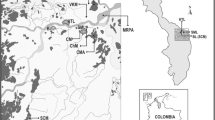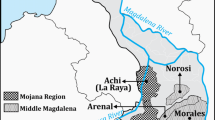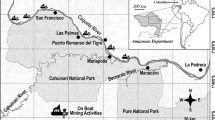Abstract
We investigated mercury (Hg) exposure of food web and humans in the region of Kedougou, Senegal, where Hg is used for gold amalgamation in artisanal small-scale gold mining (ASGM). For this purpose, total mercury (THg) concentration was determined in eight fish species and two shellfish species from Gambia River and in human hair from 111 volunteers of different age and sex, living in urban locations (Kedougou and Samekouta) or in ASGM areas (Tinkoto and Bantako). THg concentrations in fish samples range from 0.03 to 0.51 mg kg−1 wet weight (ww) and 0.5 to 1.05 mg kg−1 ww for shellfish. THg concentrations in fish are below the WHO guideline of 0.5 mg kg−1 ww, whereas 100 % of shellfish are above this safety guideline. In the entire set of fish and shellfish samples, we documented a decrease of THg concentrations with increasing selenium to mercury (Se:Hg) ratio suggesting a protection of Se against Hg. However, local population consuming fish from the Gambia River in the two ASGM areas have higher THg concentrations (median = 1.45 and 1.5 mg kg−1 at Bantako and Tinkoto) in hair than those from others localities (median = 0.42 and 0.32 mg kg−1 at Kedougou town and Samekouta) who have diverse diets. At ASGM sites, about 30 % of the local population present Hg concentrations in hair exceeding 1 mg kg−1, defined as the reference concentration of Hg in hair. We also evidence a higher exposure of women to Hg in the Tinkoto ASGM site due to the traditional distribution of daily tasks where women are more involved in the burning of amalgams. The discrepancy between the calculated moderate exposure through fish consumption and the high Hg concentrations measured in hair suggest that fish consumption is not the only source of Hg exposure and that further studies should focus on direct exposure to elemental Hg of population living at ASGM sites.



Similar content being viewed by others
References
Agency for Toxic Substances and Disease Registry (ATSDR) (1999) Toxicological profile for mercury. Atlanta, GA: U.S. Department of Health and Human Services, Public Health Service
Adimado AA, Baah DA (2002) Mercury in human blood, urine, hair, nail, and fish from the Ankobra and Tano River basins in southwestern Ghana. Bull Environ Contam Toxicol 68:339–346
Agusa T, Kunito T, Iwata H, Monirith I, Tana T, Subramanian A, Tanabe S (2005) Mercury contamination in human hair and fish from Cambodia: levels, specific accumulation and risk assessment. Environ Pollut 134:79–86
Airey D (1983) Mercury in human hair due to environment and diet: a review. Environ Health Perspect 52:303–316
Barbosa AC, Jardim W, Dorea JG, Fosberg B, Souza J (2001) Hair mercury speciation as a function of gender, age, and body mass index in inhabitants of the Negro River basin, Amazon, Brazil. Arch. Environ. Contam. Toxicol.40:439–444
Bassot JP (1997) Albitisations dans le Paléoprotérozoïque de l’Est du Sénégal: relations avec les minéralisations ferrifères de la rive gauche de la Falémé. J Afr Earth Sci 25:353–367
Bjornberg KA, Vahter M, Berglund B (2005) Transport of methylmercury and inorganic mercury to the fetus and breast-fed infant. Environ Health Perspect 113:1381–1385
Black FJ, Bokhutlo T, Somoxa A, Maethamako M, Modisaemang O, Kemosedile T, Cobb-Adams C, Mosepele K, Chimbari M (2011) The tropical African mercury anomaly: lower than expected mercury concentrations in fish and human hair. Sci Total Environ 409:1967–1975
Bloom N (1992) On the chemical form of mercury in edible fish and marine invertebrate tissue. Can J Fish Aquat Sci 49:1010–1017
Bravo AG, Loizeau JL, Bouchet S, Richard A, Rubin J, Ungureanu V-G, Amouroux D, Dominik J (2010) Mercury human exposure through fish consumption in a reservoir contaminated by a chlor-alkali plant: Babeni reservoir (Romania). Environ Sci Pollut Res 17:1422–1432
Bose-O’Reilly S, Drasch G, Beinhoff C, Tesha A, Drasch K, Roider G et al (2010) Health assessment of artisanal gold miners in Tanzania. Sci Total Environ 408:796–805
Belzile N, Chen Y-W, Gunn JM, Tong J, Alarie Y, Delonchamp T, Lang CY (2006) The effect of selenium on mercury assimilation by freshwater organisms. Can J Fish Aquat Sci 63:1–10 b
Belzile N, Chen YW, Yang DY, Truong HYT, Zhao QX (2009) Selenium bioaccumulation in freshwater organisms and antagonistic effect against mercury assimilation. Environ Bioindic 4:203–21
Burger J, Gochfeld M (2012) Selenium and mercury molar ratios in saltwater fish from New Jersey: individual and species variability complicate use in human health fish consumption advisories. Environ Res 114:12–23
Campbell LM, Norstrom RJ, Hobson KA, Muir DCG, Backus S, Fisk AT (2005) Mercury and other trace elements in a pelagic artic marine food web (Northwater Polynya, Baffin Bay). Sci Total Environ 351–352:247–263
Campbell L, Verburg P, Dixon DG, Hecky RE (2008) Mercury biomagnification in the food web of Lake Tanganyika (Tanzania, East Africa). Sci Total Environ 402:184–191
Clarkson TW (2002) The three modern faces of mercury. Environ Health Perspect 110(Suppl 1):11–23
Clarkson TW, Magos L (2006) The toxicology of mercury and its chemical compounds. Crit Rev Toxicol 36:609–62
Chen Y-W, Zhou M-D, Tong J, Belzile N (2005) Application of photochemical reactions of Se in natural waters by hydride generation atomic fluorescence spectrometry. Anal Chim Acta 545:142–148
Chen Y-W, Belzile N, Gunn JM (2001) Antagonistic effect of selenium on mercury assimilation by fish populations near Sudbury metal smelters? Limnol Oceanogr 46:1814–1818
Donkor AK, Bonzongo JC, Nartey VK, Adotey DK (2006) Mercury in different environmental compartments of the Pra River basin, Ghana. Sci Total Environ 368:164–167
Dos Santos LSN, Müller RCS, Sarkis JES, Alves CN, Brabo ES, Santos EO et al (2000) Evaluation of total mercury concentrations in fish consumed in the municipality of Itaituba, Tapajós River basin, Pará, Brazil. Sci Total Environ 261:1–8
Food and Agriculture Organization (2003) Report of the Expert Consultation on International Fish Trade and Food Security. Casablanca, Morocco, FAO Fisheries Report. No. 708. 213
Francesconi KA, Lenanton RCJ (1992) Mercury contamination in a semi-enclosed marine embayment: organic and inorganic mercury content of biota and factors influencing mercury levels in fish. Mar Environ Res 33:189–212
Grandjean P, Weihe P, White RF, Debes F, Araki S, Yokoyama K, Murata K, Sorensen N, Dahl R, Jorgensen PJ (1997) Cognitive deficit in 7-year-old children with prenatal exposure to methylmercury. Neurotoxicol Teratol 19:417–428
Grandjean P, White RF, Nielsen A, Cleary D, de Oliveira Santos EC (1999) Methylmercury neurotoxicity in Amazonian children: downstream from gold mining. Environ Health Perspect 107:587–591
Grandjean P, Weihe P, White RF (1998) Cognitive performance of children prenatally exposed to “safe” levels of methylmercury. Environ Res 77:165–172
Grieb TM, Driscoll CT, Gloss SP, Schofield CL, Bowie GL, Porcella DB (1990) Factors affecting mercury accumulation in fish in the upper Michigan Peninsula. Environ Toxicol Chem 9:919–930
Gochfeld M, Burger J, Jeitner C, Donio M, Pittfield T (2012) Seasonal, locational and size variations in mercury and selenium levels in striped bass (Morone saxatilis) from New Jersey. Environ Res 112:8–19
Guédron, S., D. Tisserand, S. Garambois, L. Spadini, F. Molton, B. Bounvilay, L. Charlet and D. A. Polya (2014). Baseline investigation of (methyl)mercury in waters, soils, sediments and key foodstuffs in the Lower Mekong Basin: The rapidly developing city of Vientiane (Lao PDR). Journal of Geochemical Exploration 143:96–102
Hammerschmidt C, Wiener JG, Frazier BE, Rada RG (1999) Methylmercury content of eggs in yellow perch related to maternal exposure in four Wisconsin lakes. Environ Sci Technol 33:999–1003
Harris RC, Bodaly RA (1998) Temperature, growth and dietary effects on fish mercury dynamics in two Ontario lakes. Biogeochemistry 40:175–187
Ikingura JR, Akagi H (1996) Monitoring of fish and human exposure to mercury due to gold mining in the Lake Victoria goldfields. Tanzania Sci Total Environ 191:59–68
Ikingura J, Akagi H, Mujumba J, Messo C (2006) Environmental assessment of mercury dispersion, transformation and bioavailability in the Lake Victoria goldfields, Tanzania. J Environ Manag 81:167–173
Johnson CL (2004) Mercury in the environment: sources, toxicities, and prevention of exposure. Pediatr Ann 33(7):437–442
Kajiwara Y, Yasutake A, Adachi T (1996) Methylmercury transport across the placenta via neutral amino acid carrier. Arch Toxicol 70:310–314
Khan M, Wang F (2009) Mercury–selenium compounds and their toxicological significance: toward a molecular understanding of the mercury-selenium antagonism. Environ Toxicol Chem 28:1567–1577
Kidd K A, Bootsma H A, Hesslein R H, Lyle Lockhart W, Hecky R E (2003) Mercury concentrations in the food web of Lake Malawi, East Africa. Journal of Great Lakes Research 29 Supplement 2:258–266
Kidd KA, Stern G, Lemoalle J (2004) Mercury and other contaminants in fish from Lake Chad. Africa: Bull Environ Contam Toxicol 73:249–256
Kwaansa-Ansah EE, Agorku SE, Nriagu JO (2011) Levels of total mercury in different fish species and sediments from the upper Volta basin at Yeji in Ghana. Bull Environ Contam Toxicol 86:406–409
Lawrence DM, Treloar PJ, Rankin AH, Harbidge P, Holliday J (2013) The geology and mineralogy of the Loulo mining district, West Africa: evidence for two distinct styles of orogenic gold mineralization. Econ Geol 108:199–227
Lebel J, Mergler D, Branches F, Lucotte M, Amorim M, Larribe F, Dolbec J (1998) Neurotoxic effects of low-level methylmercury contamination in the Amazonian basin. Environ Res Environ Res 79:20–32
Mason RP, Laporte JM, Andres S (2000) Factors controlling the bioaccumulation of mercury, methylmercury, arsenic, selenium, and cadmium by freshwater invertebrates and fish. Arch Environ Contam Toxicol 38:283–297
Matsubara J, Machida K (1985) Significance of elemental analysis of hair as a means of detecting environmental pollution. Environ Res 38:225–238
McDowell, M.A.,C.F. Dillon, J. Osterloh, P. M. Bolger, E. Pellizzari, R. Fernando, R. M. de Oca, S.E. Schober, T. Sinks, R.L. Jones and K. R. Mahaffey (2004). Hair Mercury Levels in U.S. Children Women of Childbearing Age: Reference Range Data from NHANES 1999–2000. EnvironmentalHealth Perspectives 112:1165–1171
Mezghani-Chaari S, Hamza A, Hamza-Chaffai A (2011) Mercury contamination in human hair and some marine species from Sfax coasts of Tunisia: levels and risk assessment. Environ Monit Assess 180:477–487
Mortada WI, Sobh MA, El-Defrawy MM, Farahat SE (2002) Reference intervals of cadmium, lead and mercury in blood, urine, hair and nails among residents in Mansoura City, Nile Delta, Egypt. Environ Res 90:104–110
Murata K, Weihe P, Budtz-Jorgensen E (2004) Delayed brainstem auditory evoked potential latencies in 14-year-old children exposed to methylmercury. J Pediatr 144:177–183
Niane B, Moritz R, Guédron S, Ngom PM, Pfeifer HR, Mall I, Poté J (2014) Effect of recent artisanal small-scale gold mining on the contamination of surface river sediment: case of Gambia River, Kedougou region, southeastern Senegal. J Geochem Explor 144:517–527
Olivero J, Johnson B, Arguello E (2002) Human exposure to mercury in San Jorje River basin, Columbia (South America). Sci Total Environ 289:41–47
Orihel DM, Paterson MJ, Blanchfield PJ, Bodaly RA, Hintelmann H (2007) Experimental evidence of a linear relationship between inorganic mercury loading and methylmercury accumulation by aquatic biota. Environ Sci Technol 41:4952–4958
Ouédraogo O, Amyot M (2013) Mercury, arsenic and selenium concentrations in water and fish from sub-Saharan semi-arid freshwater reservoirs (Burkina Faso). Sci Total Environ 444:243–254
Programme d’Appui au Secteur Minier PASMI (2009) Cartographie géologique du Sénégal au 1/500000. Rapport final. Projet 9 ACP SE 009
Peterson SA, Ralston NVC, Whanger PD, Oldfield JE, Mosher WD (2009) Selenium and mercury interactions with emphasis on fish tissue. Environ Bioindicat 4:318–334
Ralston CR, Blackwell JL III, Ralston NVC (2006) Effects of dietary selenium and mercury on house crickets (Acheta domesticus L.): implications of environmental co-exposures. Environ Bioindic 1:98–109
Ralston NVC, Raymond LJ (2010) Dietary selenium’s protective effects against methylmercury toxicity. Toxicology 278:112–123
Rashed MN (2001) Monitoring of environmental heavy metals in fish from Nasser Lake. Environ Int 27:27–33
Sakamoto M, Kubota M, Matsumoto S, Nakano A, Akagi H (2002) Declining risk of methylmercury exposure to infants during lactation. Environ Res 90:185–189
Sivaperumal P, Sankar TV, Viswanathan-Nair PG (2007) Heavy metal concentrations in fish, shellfish and fish products from internal markets of India vis-a-vis international standards. Food Chem 102:612–620
Sylla M, Ngom PM (1997) Le gisement d’or de Sabodala (Sénégal Oriental): une minéralisation filonienne d’origine hydrothermale remobilisée par une tectonique cisaillante. J Afr Earth Sci 25:183–192
Sørmo EG, Ciesielski TM, Øverjordet IB, Lierhagen S, Eggen GS, Berg T et al (2011) Selenium moderates mercury toxicity in free-ranging freshwater fish. Environ Sci Technol 45:6561–6566
UNEP/WHO (2008) Guidance for identifying population at risk from mercury exposure UNEP/WHO, Geneva, Switzerland
United States Environmental Protection Agency (1997) Mercury Study Report to Congress Volume IV: An Assessment of Exposure to Mercury in the United States. 293 p. http://www.epa.gov/ttn/oarpg/t3/reports/volume4.pdf
Voegborlo RB, Matsuyama A, Adimado AA, Akagi H (2010) Head hair total mercury and methylmercury levels in some Ghanaian individuals for the estimation of their exposure to mercury: preliminary studies. Bull Environ Contam Toxicol 84:34–8
World Health Organization (2004) Sixty-first Report of the Joint FAO/WHO Expert Committee on Food Additive (JEFCA)
Zahir F, Rizwi SJ, Haq SK, Khan RH (2005) Low dose mercury toxicity and human health. Environ Toxicol Pharmacol 20:351–60
Xue F, Holzman C, Rahbar MH, Trosko K, Fischer L (2007) Maternal fish consumption, mercury levels, and risk of preterm delivery. Environ Health Perspect 115:42–47
Acknowledgments
The authors thank the Lombard Foundation (Geneva, Switzerland), Schmidheiny Foundation (Geneva, Switzerland) and Sida-UNESCO project 503RAF2000 for financing the study; and the Geological Survey of Senegal (DMG), University Cheikh Anta Diop (Dakar), Dr Diongue and the team of Kedougou hospital and RandGold Company Senegal for their logistic help; and Dr Sarr of the Animal Biology Department at the University Cheikh Anta Diop for fish identification.
Author information
Authors and Affiliations
Corresponding author
Additional information
Responsible editor: Philippe Garrigues
Rights and permissions
About this article
Cite this article
Niane, B., Guédron, S., Moritz, R. et al. Human exposure to mercury in artisanal small-scale gold mining areas of Kedougou region, Senegal, as a function of occupational activity and fish consumption. Environ Sci Pollut Res 22, 7101–7111 (2015). https://doi.org/10.1007/s11356-014-3913-5
Received:
Accepted:
Published:
Issue Date:
DOI: https://doi.org/10.1007/s11356-014-3913-5




